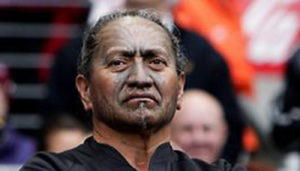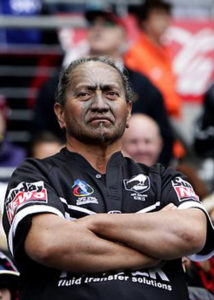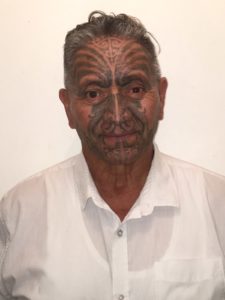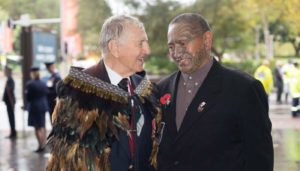What would you do if a potential recruit walked in with a face tattoo? This story sheds some light on why HR needs to look beyond the ink.

Welcome to HRM’s first ever audio-led feature. If you’re keen to hear it, just click play and be sure to give it time to load (the file is 14mb). But if you’d prefer, a version of the story can be read below. If you do listen, make sure you scroll down so you don’t miss out on the images of Rawiri.
Tattoos and employment
Do you have a tattoo? Or do you work with someone who does? Chances are yes. And it’s likely that the tattoo symbolises something significant, whether it be a quote from a song or a portrait of a loved one.
Research firm McCrindle conducted a nation-wide survey of 1,013 people and found 20 per cent of respondents indicated they had a tattoo.
According to the firm’s founder, Mark McCrindle, tattoos are becoming more popular because many other ‘life-markers’ have disappeared from Australians’ lives. “In a generation tattoos have been transformed from a sign of rebellion and nonconformity to symbols of personal meaning and life-change.”
While that may be the case in Australia, it’s different across the ditch. Māori people and tattoos (tā moko) have a strong spiritual connection and that has been the case for centuries – and it’s presented challenges.
In 1907 the New Zealand government passed the Tohunga Suppression Act which outlawed tohunga (Māori experts) from performing their spiritual and educational duties, such as passing on Māori knowledge and rituals to younger generations. The Act caused the loss of a lot of knowledge and, because of that, the tā moko was on the brink of extinction. In 1962 the act was repealed and a year later the Te Puia museum opened the Māori Arts and Crafts institute, which has played a pivotal role in the resurgence of Māori culture and language.
It seems the stigma surrounding tattoos in general is shifting too, at least in the USA. Researchers from the University of Miami and Western Australia (including Andrew Timming FCAHR) found no evidence that people with tattoos are discriminated against in employment, either in their earnings or in recruitment.
That being said, you have to think there is a difference between a full facial tattoo, and something less conspicuous.
Since people have started adopting the tā moko again – HRM thought it would be good to talk to an Australian worker who has one about what his tā moko means to him and whether or not he has faced prejudice.
“I walked in, I walked out”
 Rawiri Iti is the national president of the Māori Wardens Australia, a group dedicated to providing a community for Māori people and helping those who are less fortunate. He served in the New Zealand territorial forces for 14 years and has an impressive resume, boasting a 28 year international career in the railway industry, working both in New Zealand and Europe. He was also a part of the resurgence of the tā moko during the 1970s in New Zealand.
Rawiri Iti is the national president of the Māori Wardens Australia, a group dedicated to providing a community for Māori people and helping those who are less fortunate. He served in the New Zealand territorial forces for 14 years and has an impressive resume, boasting a 28 year international career in the railway industry, working both in New Zealand and Europe. He was also a part of the resurgence of the tā moko during the 1970s in New Zealand.
When Rawiri arrived in Australia he had just left a senior role in Germany to be with his family. Despite his experience and knowledge Rawiri had to, at nearly 60 years old, change his career and become a labourer.
“I felt muscles in me body I hadn’t felt in years,” he says.
It took six months to find work in what he calls a “young man’s game”, and along the way he was met with prejudice.
Picture yourself in this scenario. If someone walked into an interview, dressed appropriately, neat and smiling but they had a tattoo covering a majority of their face – how would you react? You may stare, you may ask them why they had a tattoo or question whether or not the tattoo would affect their role. Or you may react how this recruiter reacted to Rawiri.
The interviewer, instead of asking Rawiri about his tattoo, said “the job’s been taken.”
“I basically walked in and walked out,” Rawiri says. “It was the mere fact that I wear the full facial tattoo that for whatever reason the people who were interviewing me felt threatened or couldn’t understand the reason why – no questions were asked.”
The people who turned away Rawiri also turned away a hard worker, and someone who would go on to prove his worth in the labouring industry.
But it is hard to blame people for their apprehension around tattoos – some forms of face tattoos, like tear drops, are associated with crime, murder and gangs. For a long time the tā moko had negative connotations that connected the wearer to violence and crime and that is largely due to one gang – the Mighty Mongrels Mob. The gang even made international headlines. They said their faces would give you “sleepless nights.” But while some gang members wore tā moko, the vast majority of those with a tā moko have one for profound reasons.
For them, a Māori tattoo is worlds apart from crime, it is a sacred, and noble representation of Māori heritage.
The tā moko
The tā moko is a traditional tattooing method and every tā moko is personal to the wearer and is shaped from their history. Rawiri’s tā moko tells a story of the generations before him and the generations to come. In Māori culture, life and time can be viewed as looping in on itself, coiling the past, present and future together. To visualise that I recommend thinking of a budding fern, which in Māori is called ‘koru’.

Like many words in Māori, koru has many meanings but it is most closely associated with a budding fern. The fact that the koru spirals outwards symbolises change. But since that spiralling points back to the koru’s centre, it also shows that all growth and change also loops back to its beginning. Rawiri shares that same outlook on life.
Rawiri says that western culture will typically say that “your past becomes the past,” but “our [past] becomes the future and our future becomes the past.”
His philosophy is evident throughout his tā moko.
 “As you’re looking at me, the line down the centre of my nose is our spiritual line and it’s always been said that our spiritual line keeps us together. From that spiritual line, our tīpuna (our elders) that have passed, become a part of who we are,” says Rawiri.
“As you’re looking at me, the line down the centre of my nose is our spiritual line and it’s always been said that our spiritual line keeps us together. From that spiritual line, our tīpuna (our elders) that have passed, become a part of who we are,” says Rawiri.
On top of his head are markings which represent his grandparents, his parents, his bond with his wife and their children, and on the sides of his face are spirals that signify he has older brothers. He says the line keeps them physically and spiritually together.
Traditionally, a wearer of a tā moko will have their mother’s whakapapa (lineage) marked on the left side of their face because “it is closest to the heart”. Rawiri decided instead to mark his father’s whakapapa on the left because while he was born in his mother’s iwi (tribe) he was “staunch” (loyal) to his father’s whakapapa.
“The design that is on my nose is a representation of the knowledge that my parents and grandparents had given me while I was growing up and so everything that is under my nose is what I call ‘the spoken word’,” he says.
“As a young person we were nurtured by our grandparents and parents even though at times we didn’t want to know anything from them. But as we get older those words of wisdom become clear and we live by them.
“As you see on the chin, this is the marking of my future – I didn’t know when I got my tā moko done what was ahead of me but what was in my mind’s eye was that I was going to have children and grandchildren.”
So far he has one great grandchild but according two the markings on his chin, he has two more yet to come.
“The tā moko is the most precious thing that I have done to my body that I will wear with dignity and honour.”
Policy vs culture
Grevis Beard, director of WorkLogic, is a workplace culture consultant and a former lawyer who says that it’s possible that when people interviewed Rawiri they focussed on his tā moko – which they had never seen the like of before – instead of seeing his experience.
“When you look at what can cause discrimination to occur, it’s not that people willingly decide that they’re going to treat them unfairly because they’re prejudiced – it’s simply because they’ve never met someone from that background,” says Beard.
The fact is that many employees will have a tattoo and sometimes they’re culturally significant. If a workplace were to ban them, or fire someone based off of a tattoo, it could have dire consequences.
“People have tattoos for a variety of reasons. An individual who is Māori, who has a tattoo due to cultural reasons, would be covered by a separate attribute under discrimination legislation – it would be ethnicity or race and in that regard it is very clear that race discrimination is unlawful.”

From Rawiri’s perspective putting workplace policies in place that allowed for cultural tattoos may help but a wider societal shift is also required.
“I think we need to understand the environment we live in today. When I was growing up, it was said that the Māori language means nothing to anyone outside of New Zealand – so why learn it? But today, the Māori language is being taught globally.
“We need to understand that if we truly believe in our culture, our heritage and our whakapapa then we will work our way through it,” says Rawiri.
“I think time will tell whether policies are warranted or not.”
Beard says before HR can put a policy in place, it has an important role to play in making someone like Rawiri feel comfortable in the workplace. Doing that could be as simple as making company values around inclusion and diversity known to employees.
Rawiri’s story is a clear message that first impressions aren’t everything. When it comes to someone’s appearance, there is often more meaning lying beneath the surface.
Grevis Beard is a highly-experienced and widely-respected lawyer, acclaimed author and workplace investigator. You can hear more from him at AHRI’s 2019 National Convention and Exhibition.


Many thanks for the article and the challenge it presents. I would hope that in this day, the discrimination experienced by Rawiri as described in his story would be rare, and that those of us involved in recruitment would be aware enough of differences in tattoo types to distinguish between a prison badge and cultural markings!
As a workplace investigator of 35 years experience, and a Māori Australian, and a AHRI member, I also wear ta moko around my wrist. When I owned my previous company, Wise, I used to cover it up because of prejudices. Now I work in Capital Workplace, which is a supply nation, culutral sensitive workplace I have no need to. There is a strong need to educate around cultural sensitivities.